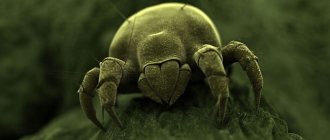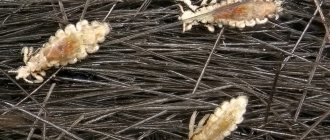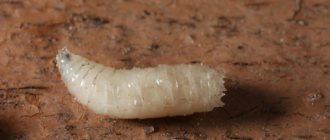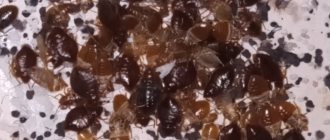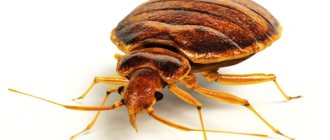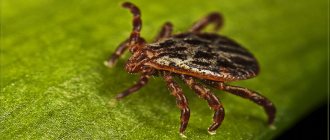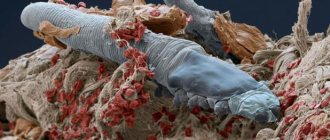Description and types
Ticks have inhabited the planet since ancient times. They are not insects, as most people believe, but belong to the class of arachnids, which includes more than 25 thousand species. Their sizes vary from 0.1 to 0.5 mm; it is extremely rare to find representatives of arthropods about 3 mm in size. Ticks do not have wings. They move in space using the sensory apparatus, since they do not have an organ of vision. They can smell the scent of a future victim at a distance of 10 meters.
Depending on the structure of the body, oxygen supply occurs in different ways. Those arachnids that have a fused head and chest breathe through the skin or trachea, and armored representatives have special spiracles.
The main types of ticks include:
- ixodidae;
- argasaceae;
- armored;
- gamas;
- subcutaneous;
- scabies;
- ear;
- dusty;
- arachnoid;
- nautical;
- predatory;
- pasture;
- brown dog
Appearance and lifestyle of ixodid ticks
Ixodid ticks (Ixodidae) belong to the class of arachnids of the arthropod type. They feed on the blood of people and animals, being their temporary parasites , that is, they spend the main part of their lives in the natural environment, and parasitize only while feeding.
Ticks, like all representatives of the arachnid class, have eight walking legs. Their body consists of two sections: the head (gnatosomes) and the body (idiosomes). The idiosome is covered with a chitinous cuticle, which, thanks to the folds and furrows that pepper it, is capable of stretching. This allows the parasite, having sucked blood, to increase in size several times - from 2-4 mm (in a hungry state) to 1 cm (when saturated).
The head of a tick is a complex structure that is firmly attached to the skin of the victim and does not allow the attached parasite to be easily pulled out.
On a note
The tick's oral apparatus consists of chelicerae, with which it cuts through the host's skin like knives, a proboscis covered with spines curved towards the base, and pedipalps, which perform a tactile function. The spines of the proboscis, like the hooks of a harpoon, firmly hold it inside the wound, and in some species the saliva continuously secreted by the bloodsucker freezes, forming a very strong structure in the thickness of the skin.
Tick head (macro photography).
The development cycle of ixodids consists of several stages. The eggs laid by the engorged female hatch into larvae. They live mainly on the ground or crawl into holes; small rodents and birds become their victims. Having had enough, the larva molts, turning into a nymph.
Nymphs prey on larger animals, and after feeding they molt into adults. This is the adult stage of ticks in which they mate and the females, having fed, lay eggs and then die.
This is interesting
During the life cycle, the parasite usually feeds three times and each time on a new victim - such ticks are called three-host ticks. There are single-host and two-host species in which all or several stages of development take place on one animal, but this is a rare exception.
Ticks lie in wait for their victims on the ground, in the forest floor, on the tips of blades of grass and branches of bushes. For these arachnids, high humidity is important, so they do not rise to a height of more than a meter from the surface of the earth.
The parasite freezes, waiting for prey at the chosen place to lie in wait. When he begins to feel her approach, he becomes more active and strives to crawl onto her.
Usually the bloodsucker waits for the prey to pass by the blade of grass on which it is sitting, but if contact does not occur, and the prey continues to be felt and is at a distance of several meters, it can descend from its post and crawl towards it.
A tick waiting for a victim with its front legs characteristically extended to the sides.
On a note
On the front legs of the tick there are olfactory organs that analyze the composition of the surrounding air. By making oscillatory movements with these legs, the tick better senses the smell of prey passing nearby. In addition to the smell, the tick senses the approach of the victim by the presence of carbon dioxide in the air it exhales and the thermal radiation emanating from it.
The tick does not bite its victim right away: for some time it searches for a convenient place on its body, where it will be easier for it to reach the blood vessel, and where it is more difficult for the victim to remove the parasite.
The tick, having attached itself to the host, spends from an hour to several weeks and increases in size several times due to the blood it drinks. Then, having fed, the parasite falls away and looks for a secluded place either to molt and move to the next stage of development, or, if it is an adult female, a place to lay eggs.
Ticks are not active all year round. During periods of winter cold and summer heat, they plunge into a state of diapause, during which all their metabolic processes slow down.
Parasites are most active in spring and late summer – early autumn. They wake up around mid-April, remain active throughout May, disappear in June-July and become active again in August and September. Bloodsuckers enter hibernation in October-November, when temperatures reach sub-zero temperatures.
Much of the behavior of ixodids depends on the climate of a particular region. For example, in places where the summer is hot and dry, ticks will remain in diapause during the summer months, but where it is cold and wet, they will remain active.
It is also useful to read: Red mites (red mites) and their danger to humans
This lifestyle of ticks suggests that they can either become victims of any animal that feeds on small arthropods and search for them among the grass, or be accidentally swallowed by herbivores along with plant food. It is also possible that the attached tick will be eaten directly from the host’s skin.
What do they eat?
Where ticks live and what they feed on is of interest to many people who want to prevent encounters with these arthropods. According to the type of nutrition, arachnids can be divided into:
- Saprophages that feed exclusively on organic debris.
- On predators that parasitize plants and animals.
Feeding on plant juices, mites cause significant damage to agriculture. Scabies and field arachnids eat particles of human epidermis. Granary feeders feed on decaying plant remains, flour, and grain. For subcutaneous mites, the food is the fat of human hair follicles, while ear mites consume fat from the hearing aids of animals.
Having taken their place on a branch or blade of grass, blood-sucking predators await their prey. Having waited, they attach themselves to it using paws with claws and suction cups, and then gradually reach the feeding site. The victim of arachnids is usually not only humans, but also other representatives of ticks.
Parasites are carriers of infectious diseases, so their bite can be fatal to humans. Arachnids can go without food for about three years, but once they receive food, they increase in weight several times.
Natural enemies
There are a large number of means of combating parasites. Nature also made sure that their numbers did not grow indefinitely. Arachnids are an important link in the food chain for many insects, birds and other animals.
Natural enemies that feed on ticks in nature and thereby control the arachnid population include:
- frogs;
- other types of arachnids;
- birds (sparrows, thrushes, starlings and others);
- ground beetles;
- dragonflies;
- ants;
- wasps;
- riders.
Natural enemies for ticks in nature are also fungal spores, which have a detrimental effect on them and cause fungal diseases in them. Therefore, it is so important to prevent large-scale burning of grass and treatment of large areas with acaricides. This will lead to disruption of the natural balance and as a result, not only the parasites themselves will die, but also their enemies. In addition, most of the tick eggs will survive, which will lead to their rapid reproduction and spread.
Hunters of bloodsuckers among insects
Ixodids can also become prey to any predatory invertebrate. Ticks are eaten by ants, ground beetles, lacewings, dragonflies, bedbugs, spiders, predatory centipedes and other representatives of arthropods. In addition, these bloodsuckers themselves can be attacked by other parasites: wasps and wasps.
Ground beetles (Carabidae) are a large family of flightless predatory beetles that live in almost all latitudes - from tundra to tropical forests and deserts. They actively move in search of prey, and their victims are any invertebrates that they can catch: insects, worms, mollusks, and also ticks.
The ground beetle is a carnivorous beetle. It feeds on many insects, including ticks.
Lacewings (Chrysopidae) are a family of graceful insects of the order Reticuloptera. They feed on pollen and nectar of flowers, but their larvae are aggressive predators that actively eat aphids, mites, scale insects and other small arthropods.
Active enemies of ixodid ticks and their egg clutches are ants, for which a engorged tick is a tasty prey. In addition, the smell of formic acid repels parasites, and they avoid being near anthills.
It is also useful to read: Memo for parents on the topic “Beware of ticks!”
Among the insects that feed on mites, ichneumon wasps and parasitic wasps stand out. Their peculiarity is that they do not eat their victims themselves, but lay eggs inside their bodies. The hatched larvae devour their host alive from the inside.
Parasitic wasps paralyze their prey with poison and hide them in nests where they lay eggs. And the victims of the parasites continue to lead a normal life until the parasite larvae grow and leave their body to pupate. After this, the exhausted owner dies.
Ixodiphagus hookeri is known among parasitizing ixodid ticks. This species is found throughout the world except Antarctica and parasitizes ticks of the genera Ixodes, Dermacentor, Rhipicephalus, Haemaphysalis, Hyalomma, Ornithodoros and Amblyomma. Its most common victim is the dog tick Ixodes ricinus, but it does not attack the meadow tick (Dermacentor reticulatus).
This parasite lays eggs in hungry nymphs, and its larvae hatch after the infected arachnid has had its fill. They parasitize the tick for 28 to 70 days.
There are special parasites - ovi- eaters, which lay their eggs in the eggs of other arthropods, including the eggs of ticks, piercing them with a thin ovipositor. The developing larva eats the insides of someone else's egg.
Meaning in nature and human life
It is difficult to find a place on Earth where these representatives of arachnids do not live. Ticks are found wherever possible: in the forest, in a personal plot, in a garden, and even in city parks and squares. All types differ in structure, color, and size.
Some of them cause irreparable harm to plants, others are parasitic on animals and humans, and still others are blood-sucking specimens.
People have been fighting them for a very long time, but the importance of ticks in nature should still be recognized.
For example, ixodid arthropods are the most dangerous to humans, as they carry deadly infectious diseases. Despite this, they play an important role in the ecosystem, as they regulate natural selection. If such a tick bites a weak animal, it will die, and strong ones will develop immunity. This helps maintain balance among animals on Earth. Thus, it follows that some representatives of arthropods, although of great importance for nature, still cause great harm to people.
The role of ticks in nature
The role of ticks in nature is extremely great; they are integral links in various natural biological chains. Their participation in soil formation processes is very important, since saprophytic forms are capable of decomposing organic residues. By doing this, they contribute to the unique movement and renewal of the soil mass, carry out the decomposition of complex organic substances into simpler mineral ones, thereby participating in the cycle of matter in nature. They also spread various microorganisms across the soil profile, eat small insects and some parasitic mites, serve as orderlies, clean plants from spores of some parasitic fungi, and much more.
Unfortunately, recently the negative impact of ticks on human health has become increasingly pronounced, which will be discussed in detail below. A detailed analysis of the role of mites in nature would take too much time, so we will limit ourselves to a brief excursion into the main points of their participation in processes in the environment, as well as in the human economy.
Some species of mites serve as intermediate hosts for a number of parasitic tapeworms (for example, representatives of the family of oribatids or oribatid mites serve as intermediate hosts for the cestode Moniezia expanse, which causes moniesiosis in ruminants). Others (in particular, the so-called thyroglyphids) are pests, destroying and making unusable stocks of grain and flour (flour and elongated mites), dairy products, vegetables, wine (cheese, onion and wine mites). In addition, these types of ticks are pathogenic for humans.
For example, if accidentally ingested in food, they can cause acute gastrointestinal disorders, and if inhaled, they can cause asthma and catarrh of the upper respiratory tract. Many species parasitize cultivated plants, causing their weakening and death. These include, in particular, the common spider mite, which parasitizes cotton and melons; the cereal mite, which, as the name suggests, parasitizes cereals; the so-called gall mites, are specialized parasites of plants. Their brightest representatives are the grape felt mite and the currant bud mite. In addition, spider mites can carry gray rot and other plant diseases. There are also many species of mites with gnawing mouthparts and feeding on fungi, their spores, soil algae, and yeast. Among the ticks there are also predatory species (bdella, rhagidia, larval stages of red beetles).
Among the truly gigantic diversity of mites, there are groups that have mastered the aquatic habitat - these are hydrachnellas, living in fresh water, and galacarides, living in the marine environment. Among them there are parasites of aquatic insects, mollusks, sea urchins, crustaceans, some feed on algae juice, invertebrate eggs, and decaying organic debris.
Finally, a large number of species are ectoparasites of humans and animals. Among them, there are both blood-sucking forms and species that feed directly on the skin and its derivatives - hair (hair mites), feathers (feather mites of birds), as well as skin secretions (glandola acne - a parasite of the human sebaceous glands).
Examples of skin parasites include foot itch - a parasite that lives on the unfeathered part of the legs of chickens and other poultry, various scabies mites - parasites of the epidermis of animals and humans (in particular, the well-known scabies itch that lives in human skin), mites of the genus Chorioptes, which cause chorioptosis large and small cattle and some others. Species that parasitize insects are also described, for example, the bee mite, which lives in the trachea of bees and is a malicious pest of beekeeping; The pot-bellied mite is also a parasite of insects; it is interesting because it can attack humans, causing severe local irritation of the skin with injections of its oral apparatus.
Benefits of arachnids
Despite the fact that people are prejudiced against ticks, there are still benefits from them. In nature and in various industries, they can provide significant assistance:
- While causing enormous damage to agriculture, they still have a positive role. Being mostly saprophages in their diet, they improve the soil by feeding on the decaying remains of plants and animals.
- Predatory representatives of this class are used to exterminate other arachnids, which suck all the juice from plants, destroying most of the crop.
- They can also rid a plant affected by spores of parasitic fungi.
- Scientists have long been interested in the enzymes contained in the saliva of arthropods. Anticoagulants, as they are also called, prevent blood clotting.
- Some types of cheese are made by attaching a microscopic mite to the rind of the product at the beginning of its ripening. This allows cheese makers to obtain a unique pattern and specific aroma, makes it porous, which allows the cheese to breathe throughout the entire ripening process.
Representatives of the arachnid class are part of the food chain and an important link in the ecosystem. For example, the favorite delicacy of some birds and frogs is ixodid ticks.
Danger and harm
Ixodid representatives of the species pose a great danger to both representatives of the animal world and people. The taiga tick, or, as it is also called, the encephalitis tick, is in first place in terms of danger, as it is a carrier of diseases such as borrelosis, encephalitis, ehrlichiosis and other diseases.
Due to the fact that the food of these arachnids is blood, infection occurs after a bite. The causative agents of fatal diseases enter the human body along with the saliva of arthropods. Other types of arachnids can also harm human health, for example, subcutaneous scabies mites, which can be carriers of diseases such as dermatitis and scabies.
Saprophages, which seem harmless at first glance, can also harm people. Due to their small size, there are no places inaccessible to them, so they live almost everywhere:
- flour - feeds on flour, cereals, grains and thereby destroys a large amount of food;
- arachnoid - destroys a garden or indoor plant;
- dust - eats particles of the epidermis, dust, and can also cause an allergic reaction and asthma in humans.
- ear - causes inconvenience to cats and dogs, moving into their ears.
Ticks, as it turns out, can be both beneficial and harmful to humans and nature as a whole. They occupy a certain ecological niche and fulfill their direct responsibilities.
Transmitted infections
Tick saliva may contain viruses and bacteria that cause dangerous diseases. The most famous of them are tick-borne encephalitis and Lyme disease (tick-borne borreliosis). These diseases are severe and can lead to disability and even death. Tick-borne piroplasmosis is often fatal for dogs, so a pet that has been bitten by a bloodsucker and suddenly becomes ill must be immediately shown to a veterinarian.
A tick cannot infect a person or animal without sucking on it, but simply by crawling over the body. For infection, its saliva must enter the victim’s blood. Infection is also possible if the contents of a parasite crushed on the skin get into a wound or scratch that happens to be nearby.
On a note
The tick bite is not noticeable: the victim does not feel pain due to the fact that the tick's saliva contains anesthetic substances. Therefore, most often, already pumped and swollen individuals are found on the body.
A person does not feel the moment a tick bites the skin, since the parasite’s saliva contains an anesthetic. The picture in purple shows a cement case made of frozen saliva.
Another route of infection with tick-borne encephalitis is milk from a goat or cow bitten by an infected tick, which has not undergone heat treatment.
